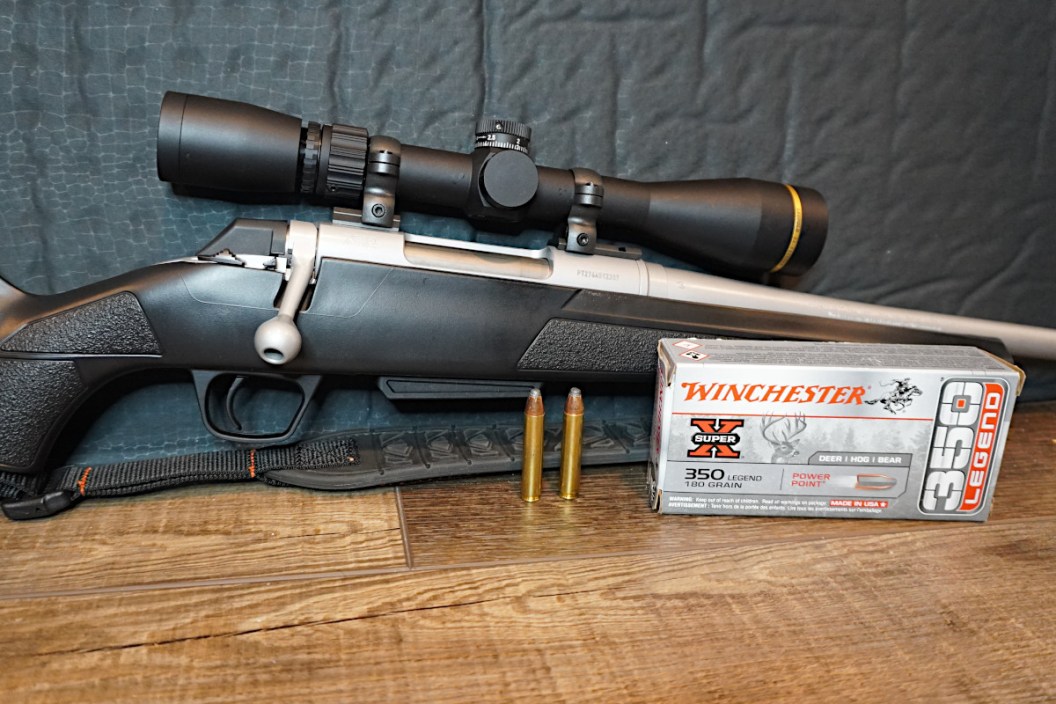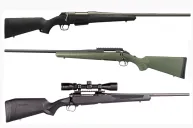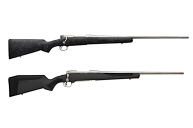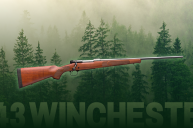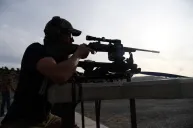I've been hunting for 23 years now and, for whatever reason, I had never dropped a buck in its tracks before. I've shot tons of deer, often with perfect shots through the lungs with a 12-gauge slug, that still somehow managed to run 150 yards or more before dying from their injuries. It just seems like that's just my bad luck, and I was beginning to wonder if I'd ever have an easy deer recovery. Then this year, I picked up a Winchester XPR chambered in 350 Legend. The very first buck I shot with this new hunting rifle ended up being my easiest recovery yet.
But I'm getting ahead of myself a little here. Like many hunters in "straight wall" cartridge states, I started rifle hunting only a few years ago, and I went with a powerful 450 Bushmaster as my first hunting rifle. Well, it didn't take me long to have buyer's remorse on the hard-kicking 450, and I traded it in after only two seasons. In its place, I decided to go with the Winchester XPR in the hottest straight wall round on the planet in the 350 Legend. And after some excellent range trips and a clean and successful harvest during the Michigan firearms season, I think it's safe to say I have my gun for deer hunting for the foreseeable future.
Specs and Features of the Winchester XPR
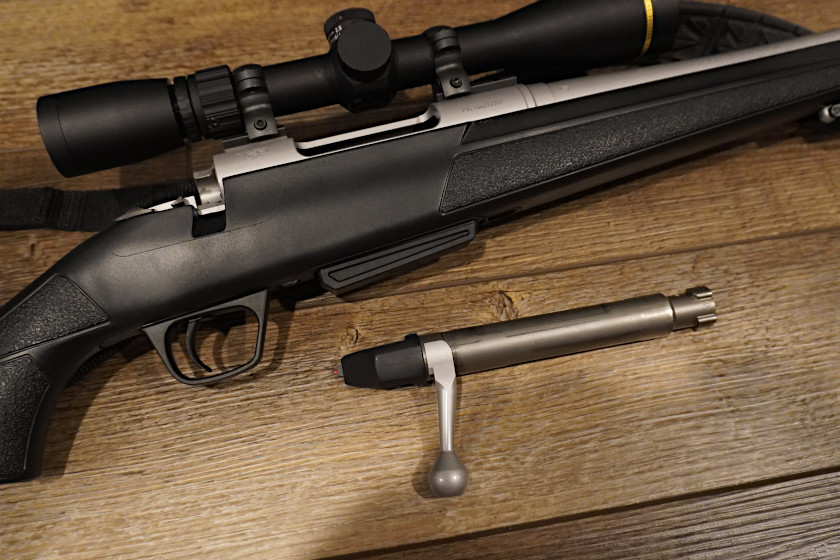
The Winchester XPR's bolt removes quickly thanks to a release. Photo by Travis Smola
Specs:
- Barrel length - 22"
- Twist rate - 1:16"
- Overall length - 42"
- Length of pull - 13¾"
- Weight - 6 pounds, 12 ounces
- Detachable magazine capacity - 4
- Barrel finish - Perma-Cote Titanium
- Stock material - Composite
- Stock finish - matte black
- Inflex small recoil pad
- Action - Short action
- Trigger material - Steel
- Bolt finish - Nickel
- Sling swivel studs
- MSRP - $709.99 (I paid about $600 for mine.)
Pros:
- Accurate
- Lightweight
- Crisp trigger system
- Affordable
Cons:
- Some hunters may not like the comb or plastic magazine
Winchester sells several different variants of the XPR chambered in the 350 Legend straight wall cartridge. I ended up going with the Titanium Perma-Cote, which I later learned from the Winchester website is a "territory exclusive" offering only to Michigan, Indiana, and Ohio. The shop where I bought it from mistakenly referred to it as stainless, so know what you're getting into before you buy. I also opted for the non-threaded barrel simply because I'm not really a suppressor guy, but the option is there for those who feel they need it. The other big difference between this and the standard XPR 350 Legend is that it has an increased capacity of four in the magazine. The standard 350 Winchester sells has only three.
While I was shopping for a new rifle, it was between this and the Ruger American rifle. I handled a lot of Rugers in store while I was shopping, and by all accounts, they are fine rifles. However, I just didn't like what I was feeling in the action. I've heard this gets better once you break those rifles in, but the XPR rifle action was buttery smooth right from the get-go, which made it an easier choice for me. I also liked how that bolt slides out like a breeze with a quick press of the unlock button.

The bolt and trigger system of the Winchester XPR. Photo by Travis Smola
Winchester also offers this bolt-action rifle with a Perma-Cote FDE or even a Tungsten Cerakote Finish. I was tempted to go for the Cerakote but couldn't find one in stock anywhere here in southwest Michigan. I didn't feel like ordering, and also decided to lower my budget slightly a little later in my search anyway. I have no regrets about going with Titanium Perma-Cote instead. These rifles are also offered with a bevy of stock configurations in several different camo schemes including True Timber Strata, and Mossy Oak DNA. There's also a Sporter version with a Turkish Walnut stock for the traditionalists out there. There is also a Compact variant that offers a slightly shorter, 20-inch barrel for anyone who wants something for tighter shooting spaces. The Compact also comes in about 4 ounces lighter. Not a huge difference, but we know for some shooters every little bit counts. As another option, Winchester also sells combo packages already fitted with a Vortex Crossfire II 3-9x40 scope already mounted.
However, for optics, I elected to put a little bit of extra money into my rifle scope this time around. I went with a Leupold VX-Freedom 3-9x40 made specifically for 350 Legend. That is the optic that all the testing for this review was done with, and it's ultimately what I used to harvest a non-typical 9-pointer in the second week of Michigan's firearms deer season.
As a hunter who's been restricted to shotguns most of my hunting career, I've spent a lot of time carrying a heavy Remington 870 12-gauge afield. And that gun can get a little hefty after a while if you've got a long walk to your stand. The XPR bolt action comes in under 7 pounds and is a true joy to tote afield.
One thing Winchester doesn't really advertise in its marketing is the fact that the XPR has a free-floating barrel, which helps significantly with the accuracy. It also makes this rifle incredibly easy to disassemble for a more-thorough cleaning. Just loosen two screws, and the entire barrel and trigger assembly pops out in one piece. No fuss, no muss. Even a novice gun owner can figure out how to take this rifle apart quite easily.
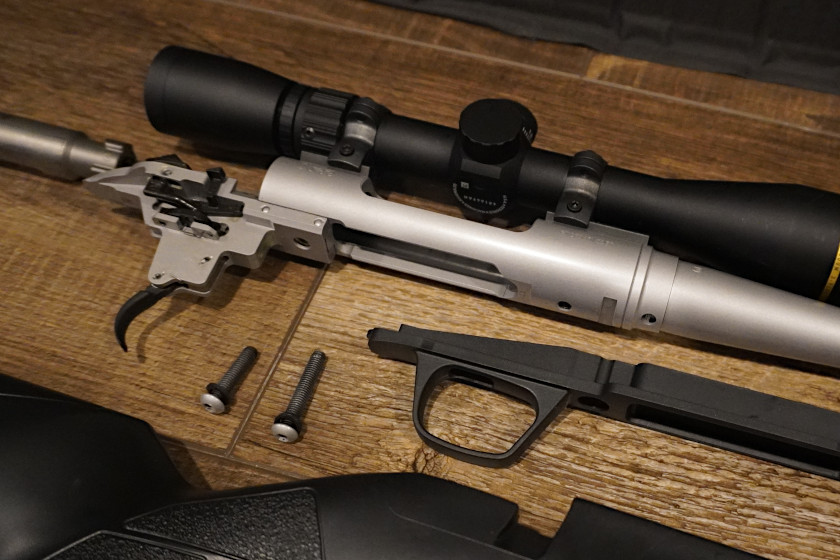
Loosen the two screws and the Winchester XPR in 350 Legend disassembles quickly and easily. Photo by Travis Smola
I also just appreciate how everything feels so ergonomic on the XPR. The two-position thumb safety just feels natural to click forward when you're ready to shoot. The stock is an incredibly simple design, but it just feels right in the hands. The checkering on the grip panels is perfect, especially for the colder conditions we get here in the Midwest. The detachable magazines are all plastic and pop out easily after depressing the release. The rifle can only hold four rounds in the magazine—but honestly, for most hunting scenarios in the Midwest, you're probably not going to need it. However, I did get the chance to test the speed of chambering that second round on my successful hunt. I'll also talk more about that later.

The Winchester XPR's magazine is plastic but durable. It only holds four rounds. Photo by Travis Smola
Because of that limited capacity, the Winchester XPR hunter is likely going to check all the boxes on legalities for hunters in states that were previously shotgun-only. The only straight wall state where this isn't going to be legal, that I know of, would be Illinois. It finally introduced a straight wall cartridge law this past season, but hunters are limited to single shot only. For hunters in Michigan, Indiana, Ohio, and Iowa, the XPR is a great option for a new, mid-priced deer rifle that isn't going to break the bank. Now that we've talked about the features, let's get into how it handled on the range and in the field.
Range Testing
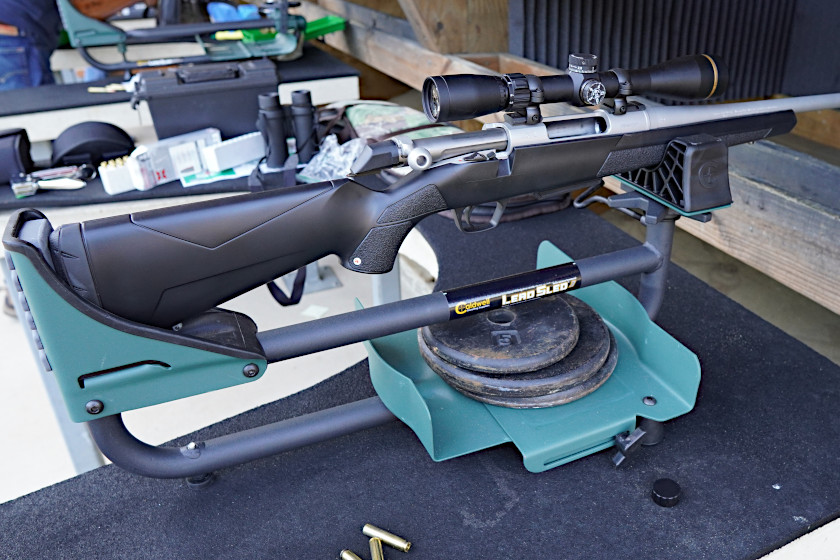
Testing was conducted using a lead sled at a 100-yard public range. Photo by Travis Smola
For my range testing and sighting in process, I decided to go with 180-grain Winchester Super-X Power-Points. From a cost savings perspective, this is some of the most affordable 350 Legend ammo on the market right now at around $35 a box. These are alloyed lead core bullets with a lead "Power-Point" soft tip that helps them expand on impact. There's also some notching to help aid in expansion. I opted for these over the box of 170-grain Hornady American Whitetail rounds I also bought, simply because I wanted the slightly heavier bullet. And if you look at the specs, there's not a whole lot of difference in muzzle velocity, energy, and trajectory anyway. The Hornady rounds are doing about 2,200 fps with 1,827 foot-pounds of energy at the muzzle. The Winchesters are doing about 2,100 fps and hitting with 1,762 foot-pounds of energy. So, about 100 feet per second of speed and roughly 100 foot-pounds of difference either way. My range test was conducted at a 100-yard public range here in southwest Michigan. I would have liked to have tested longer ranges, but I simply could not find a longer range nearby. Most Michigan hunters don't have many reasons to shoot past 100, so few ranges are longer than that.
In any case, the entire process of sighting this rifle was slightly unusual. That's mostly because my first trip to the range was nothing less than disaster. I had the rifle bore-sighted at the store I bought it at, but somewhere between there and the range, the scope got bumped majorly. It took me quite a while just to get the rifle on paper, and when I did, it was hitting extremely high. I'm talking off-the-paper high. It was at the point that I couldn't even bring the elevation all the way down because I hit the limit on the turret! And, unfortunately, I did not have the necessary Allen tool on me to re-zero the turret and keep dropping it. So, this necessitated me leaving with the rifle un-sighted and needing to make a second trip on another day.
On my second trip to the range, I brought the Allen wrench and re-bore sighted the rifle manually at 25 yards before firing my first three-shot group at 100 yards, which was still hitting high. How high, you ask? I had to bring it down 40 clicks before I finally had the elevation dialed in! Yes, you read that right. Four-zero. I'm not exactly sure what happened with this scope, but I know this was not a normal sighting-in experience. I think it was just a freak accident. In any case, the issue of the rifle hitting high was entirely an optic issue and not a problem with the rifle itself. Oddly enough, the windage from my bore sighting seemed to be dead on, so I ended up not making any adjustments to that.
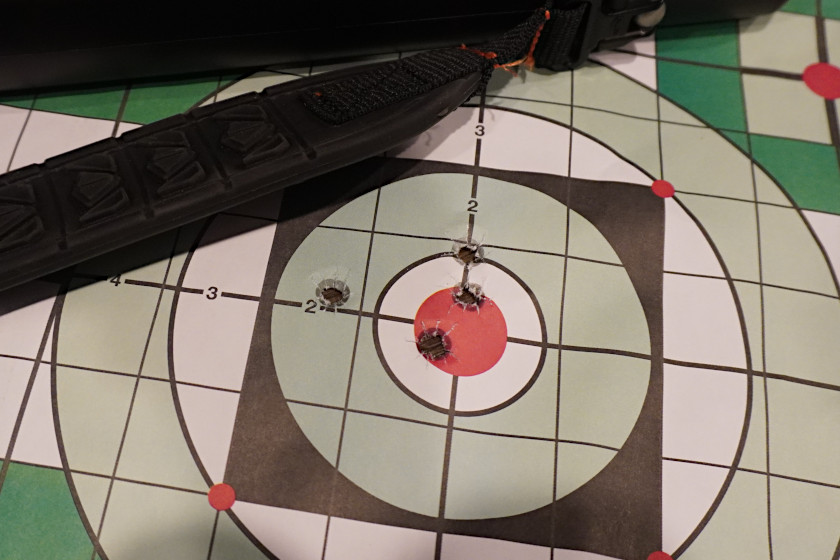
The four-shot group made by the author at 100 yards with the Winchester XPR 350 Legend. Photo by Travis Smola
After all the trouble I had adjusting the scope, I was finally able to get a somewhat decent four-shot group out of the XPR. You can see that above. It may not be the tightest group in the world, but an inch and a half group at 100 yards is plenty good enough for this hunter. I suspect it will be for most average hunters, too.
In the interest of seeing what the XPR would do, I put about 10 more rounds downrange after this group without cleansing the barrel. As expected, the groups did grow slightly larger with a little buildup. I also had a couple flyers. But at the same time, I cannot imagine a hunting situation where I'm going to need more than the four shots the rifle holds in its magazine anyway. I don't take running shots or extreme long-range shots at animals. If it's not down with the first couple, odds are I'm going to watch it run off to live another day. One thing that did impress me during this part of the testing was how quickly the XPR's barrel cools. I was able to take those range follow-ups a little more quickly than I was able to with my old 450 Bushmaster.
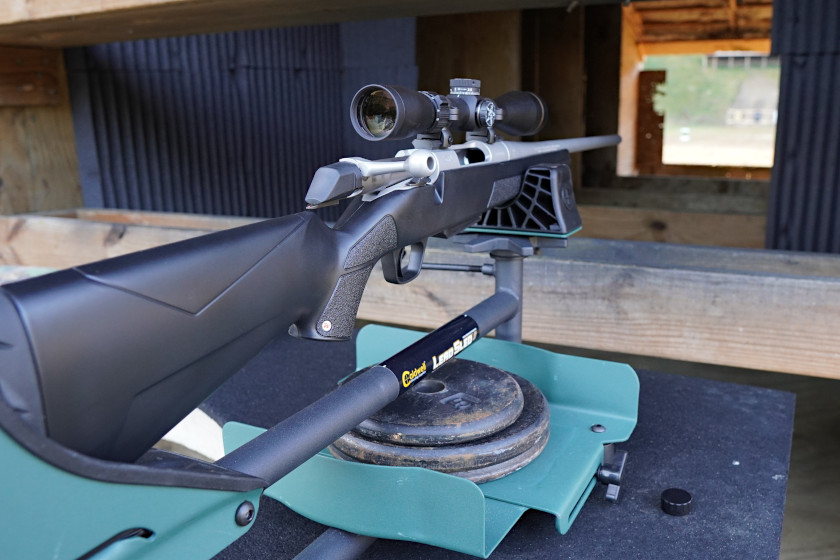
The XPR performed admirably out of a lead sled once I had it dialed in. Photo by Travis Smola
Speaking of the 450, I do want to talk a little about the recoil—or the lack thereof—from the XPR. My old 450 was akin to a 2¾-inch slug from my 12-gauge. I've gotten angry emails in the past from 450 owners who didn't like that comparison and said their rifle was better on recoil. Fair enough, that was my experience with just one rifle, mind you. That said, the 350 Legend blows the 450 out of the water in terms of kick. I would liken the XPR's recoil to my old single-shot .410 loaded with slugs. And the Inflex recoil pad soaks up most of it. No wonder so many people are buying the 350 for their kids. I wish this caliber had been an option back when I first started hunting. In any case, I feel confident in saying the Winchester XPR in 350 Legend is going to be a true pleasure to shoot for hunters of all ages. This would be a great option for the parent who wants a new hunting rifle with some real knockdown power that they can let their kids use in the youth season. You'll save a lot of money, and I can promise this gun isn't going to intimidate a recoil-shy child as a 450 might.
Finally, we need to talk about the XPR's M.O.A. trigger system. Simply put, this is a great trigger. It's a proprietary trigger with zero take-up. This is the same system Winchester uses in their Model 70 lineup, so it's not too surprising it's such a great trigger. The trigger is nice and wide, and breaks crisply and cleanly every time. I detected no creep while using it. It's probably the finest trigger on all the firearms I currently own. It helped instill a great sense of confidence in me before I wrapped things up at the range. My new 350 Legend bolt-action rifle was ready for action. I just had to wait for Michigan's firearms deer season to start.
The Winchester XPR Fills the Freezer
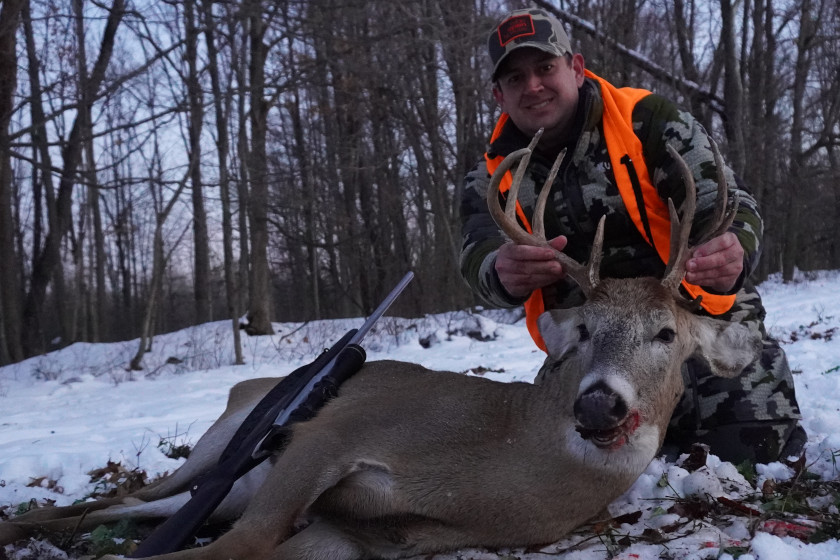
The author with the buck he harvested using the Winchester XPR in 350 Legend. Photo by Travis Smola
Opening day for Michigan's firearms season is Nov. 15, and this year nature decided to throw optimal conditions in the form of snow and freezing cold temperatures. My opening day sit from dawn until dusk was eventful, as I saw more than 20 deer including three bucks, all of which I passed. One of them crossed the property line, only for me to hear a shot about 10 minutes later. It is what it is. In any case, my first few sits of the year were marked with tons of snow that constantly accumulated on my XPR's barrel and receiver. I made sure to wipe everything down once I got in every night, but I was thoroughly impressed with how the XPR's Perma-Cote handled the elements. I was dealing with some rather bitter conditions on some of these hunts, and yet I never felt like I experienced anything it couldn't handle.
However, withstanding the elements is only one part of the equation. It's important to note how the rifle handles on animals, too. After passing up eight different bucks, I went out for an evening hunt on Nov. 22; and just a few minutes after 5 p.m., I had already seen 25 different deer on the food plot I was hunting when No. 26 entered the plot broadside at 60-70 yards. I turned up the magnification on my scope and gave the buck a good look. I could see there was four on one side and that his left side was rather goofy. I didn't recognize this buck from any of my trail camera photos, but I decided he was unique enough to be a shooter. I settled the crosshairs on his vitals and squeezed the trigger.
The shot rang out, but the buck gave no reaction. He didn't move an inch! I was dumbfounded, so I quickly worked the action on the XPR, effortlessly cycling another round in. It's at this point I should mention just how fast the action is. I felt like I only had a few seconds before this deer was going to bolt, so I had to make the most of it. Luck was on my side, and the buck was still standing there confused about what had just happened. I fired a second time, and this time the buck dropped in his tracks. He thrashed around for about 30 seconds, and then it was all over. I couldn't believe it. Finally, after 23 years, I had an easy recovery for once!
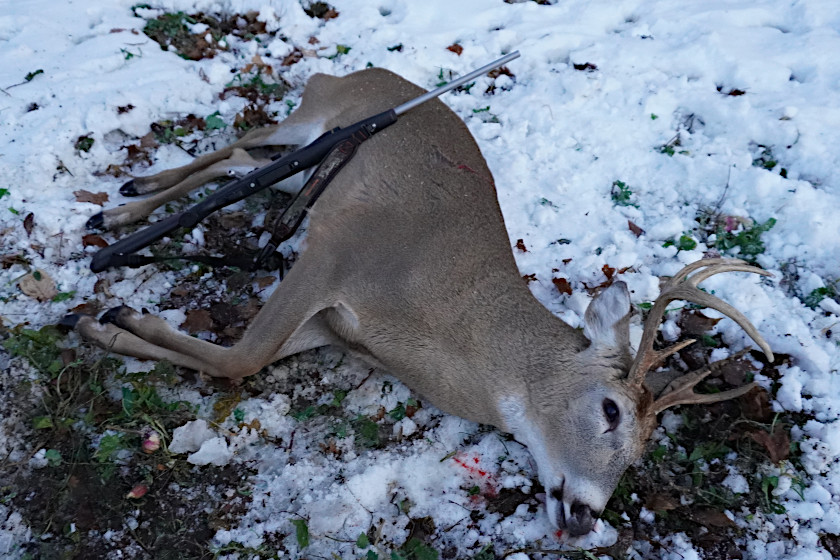
The buck the author harvested with the Winchester XPR rifle. Photo by Travis Smola
The buck ended up being a non-typical 9-point with no semblance of a main beam on his left side. He just had four points jutting straight up. One of the tines may have been a G2 in another life, stretched 8 inches. When I first lifted the buck's head up, I was surprised to discover he had a small, 2-inch drop tine that curled out slightly from the base. My first drop-tined buck ever. The G2 and G3 on the normal right side were both 7 inches exactly. Not a high-scoring buck, but a unique one.
After examining the buck, I discovered my first shot had missed completely. Chalk it up to buck fever maybe. I don't think it was the rifle's fault. I just pulled the first shot. My second shot struck a little farther back than I would have liked, but the height was right. I was going for a high shoulder shot. I think it just clipped the backs of both lungs.
When we raised the buck up with a tractor a little later, I was surprised to see the bullet had not exited the deer. I looked for it but could not find it during the field dressing process. I would have liked to have seen the expansion. I may still go back in the spring to look around where the gut pile was left. If I find it, I'll update this article.
In any case, when I opened the chest cavity, a veritable avalanche of blood came pouring out. It seems most of the bleeding was internal, as there was little blood on the snow where I shot the deer. It may just be an ammo thing. I've read a few experiences from others online that said they had weak blood trails with the Power-Points. Because this deer didn't run, the jury is still out on that for me. Still, that 180-grain bullet did some serious damage to that buck. I don't think he ever knew what hit him. Overall, I'm rather pleased with the XPR's performance on this buck. This hunt basically went as perfectly as I had planned it. And I can't wait to take it out again next year. I think the Winchester XPR is going to make many more memories for me in the seasons to come.
For more outdoor content from Travis Smola, be sure to follow him on Twitter and Instagram. For original videos, check out his Geocaching and Outdoors with Travis YouTube channels.
